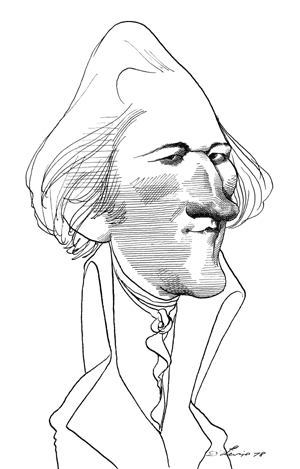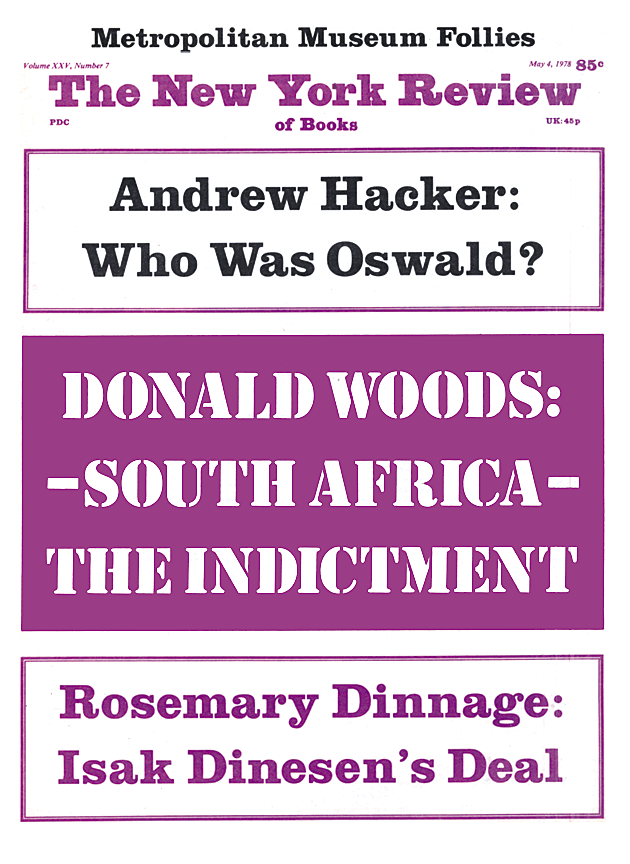Everybody knows that Alexander Hamilton was a founding father of the United States, a young father to be sure, only thirty at the time of the Constitutional Convention and just turned thirty-eight when he left behind his brilliant career as Secretary of the Treasury. James Flexner, fresh from his triumphant biography of Washington, now gives us Hamilton, but not Hamilton the founding father. This is an even younger Hamilton, his career traced only to the end of the Revolutionary War in 1783, when he had reached the age of twenty-six.
If we did not know what came later, we might wonder why the book was worth writing, for the young Hamilton in these pages, for all his precocity, seems to be forever falling short both of what he wants and of what (quite differently) his biographer appears to expect of him. The unhappy illegitimate child of a promiscuous mother, he fought his way upward but never found enough success to satisfy him. It was not enough to be aide-de-camp to Washington at the age of twenty and to be trusted by the commander in chief above his other aides. Hamilton yearned for an independent command. When he was unable to wheedle it out of his chief after three and a half years, he walked off in a huff over a trivial disagreement. By breaking security in a letter to his wife he risked giving away the strategy that brought victory at Yorktown. When Washington humored him at last by letting him lead an assault, he sulked because his capture of a British redoubt did not bring him special recognition by Congress (nor does it bring recognition by Flexner, who gives the credit to a lack of discipline in his soldiers: “There was no way Hamilton could have stopped them”).
Hamilton in politics wins no more points from Flexner. His arguments against British taxation in The Farmer Refuted in 1775 simply repeated “the standard rhetoric of the time.” His famous letter to James Duane in 1780, outlining the defects of the Articles of Confederation and calling for a constitutional convention, was similarly unoriginal (Thomas Paine had urged as much in 1776) and at the same time completely out of tune with the times and thus impracticable. It would have been a “disaster” if made public. When he argued for a stronger central government publicly in “The Continentalist” in 1781, “Perhaps most of the readers…were led to opposite conclusions from those Hamilton intended. They were induced not to desire the reforms he advocated but to fear them.” When he volunteered advice to Robert Morris, the Secretary of Finance, he told Morris only what “a veteran like Morris would obviously know and understand ten times as well.”
When he entered Congress as delegate from New York in 1782, he tried to get Washington to lead his officers in extorting pay from Congress in the famous Newburgh Conspiracy. The threat of the army’s wrath might be a means, Hamilton suggested, of frightening the states into endowing Congress with an adequate revenue. Hamilton was all too ready, then as in his later career, to play with fire in order to gain his ends. Fortunately he was unsuccessful this time. Washington would have none of his or anyone else’s schemes that might endanger the supremacy of the civil over the military. Hamilton’s only achievement in his first experience as a legislator was a dubious one. When troops in the Philadelphia barracks mutinied, Hamilton first tried to bring about a needless confrontation with them. Wiser heads prevented it, but he then prevailed on Congress to leave the city, thus paving the way for its eventual removal to New York City.
After all this we are surprised to find that Hamilton “did as much as any man—with the possible exception of Washington—to complete the Revolution by bringing the states together into a unified nation”—this in a brief concluding chapter that scans the years from 1784 to the fatal duel with Aaron Burr in 1804. In a way the belated tribute is the more striking because of the author’s diminution of Hamilton’s previous achievements and also because of his depiction of the United States in the early 1780s as wholly disunited, joined in a mere alliance against England. Sixty years ago Albert Beveridge, in a classic study of Chief Justice John Marshall, was able to magnify Marshall’s achievement by portraying the nation as virtually nonexistent until the founding fathers, with Marshall bringing up the rear, welded the unruly parts together. Flexner’s purpose is not quite the same. The tribute to Hamilton is a passing gesture, aimed more at Washington than at Hamilton. Hamilton, he wants us to see, was an outsider who remained an outsider, out of touch with the times and never at peace with himself. This precocious child, the author seems to be saying, though not in so many words, never grew up.
Advertisement
Hamilton, Flexner shows us, could be extraordinarily effective when he was working with someone who could temper his pugnacity, someone with greater sensitivity to other human beings, someone with a better sense of the possible, someone in closer touch with the times. When he struck out on his own, he could be brilliant, but his brilliance was likely to be disastrous—or sometimes simply ludicrous, as at the Constitutional Convention, when he pleaded for a senate and executive with lifetime tenure. The other members were polite enough not to laugh, but they paid no attention to his impossible proposal.
What Hamilton never ceased to need was a father, and Washington filled the role. When Hamilton was aide-de-camp, Washington could keep him under control and profit by his advice without letting him get the bit in his teeth. It was the same way when Washington was president. Hamilton chafed at his dependence and dreamed of a higher glory, but he was effective only when a greater man kept the reins on him. When Washington retired from the presidency and began to lose his grip, both on himself and on his young friend, Hamilton lost the direction he needed. It was then that he led Washington into the fiasco of preparing an army against a French invasion that never approached probability. And after Washington died, Hamilton floundered, “driven by gales and seas beyond his control.”
It is a plausible and often compelling interpretation, though sometimes overdrawn. Hamilton was not quite as insensitive to the world he lived in as he seems to be in these pages. The union of the states in the Revolution was not the mere alliance that Flexner, like Beveridge, would have it. The nation was not simply the brainchild of the founding fathers. There was a great deal of national sentiment to build on, concealed beneath the bickering of the states in Congress. Hamilton in appealing to that sentiment in “The Continentalist” (as he was to do six years later in The Federalist) was not as far out of touch with popular feeling as Flexner would have him.
Nevertheless, he was out of touch and stayed that way. It is no accident that Hamilton was never elected to a national office by popular vote. He was the least likable of the founding fathers. If this book makes him even less likable than he was and even more heedless of political realities, it still gives us a penetrating insight into his character and, most significantly, into his relationship with Washington. Flexner is too skilled a biographer to let the reader stray for long away from his subject, yet throughout the book one keeps looking over Hamilton’s shoulder to the towering figure of George Washington.
Throughout his account Flexner attacks the “Hamiltonians,” by which he means not the Federalist party but the historians who assign to Hamilton a credit that Flexner would reserve for Washington. Although the principal exemplars cited are Hamilton’s son and grandson, who both wrote biographies, and Gertrude Atherton (not exactly an authority among historians), there has indeed been a tendency, which still prevails, to see Hamilton as the éminence grise of Washington’s administration. Flexner has already shown us a Washington who was quite competent to run his own presidency. He has now shown us a Hamilton who needed Washington (though Hamilton did not know it) more than Washington needed him.
The Young Hamilton is thus a flying buttress to the author’s study of Washington and deserves to be read in conjunction with that study. Since the book stops short of Hamilton’s major achievements and discounts his minor ones, it conveys little of the man’s true brilliance and leaves the reader without a sense of the magnitude of his role in the shaping of national policy. It was Hamilton’s fiscal program, more than any other single factor, that determined the relationship of the states to the national government and of the national government to the rest of the world. Even at his most reckless Hamilton was capable of grasping implications of public decisions that others missed; even when bent on a course that has seemed to some (including Flexner in his life of Washington) to skirt the edges of treason, he kept a steady eye on what he took to be the national interest. What is more, he made his view of the national interest prevail, with Congress as well as with Washington, over the opposition of Jefferson and Madison, both of them better politicians than Hamilton, and both more in touch with the times.
How this perennial outsider was able to best the insiders and give direction to a nation he never fully understood has always been something of a puzzle, and Hamilton himself something of an enigma. The Young Hamilton does not solve the puzzle or dispel the enigma, but it does offer some clues, it does bring us a little closer to the not so young Hamilton, the founding father whom most of us respect even when we cannot fully understand him.
Advertisement
This Issue
May 4, 1978



